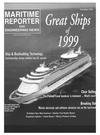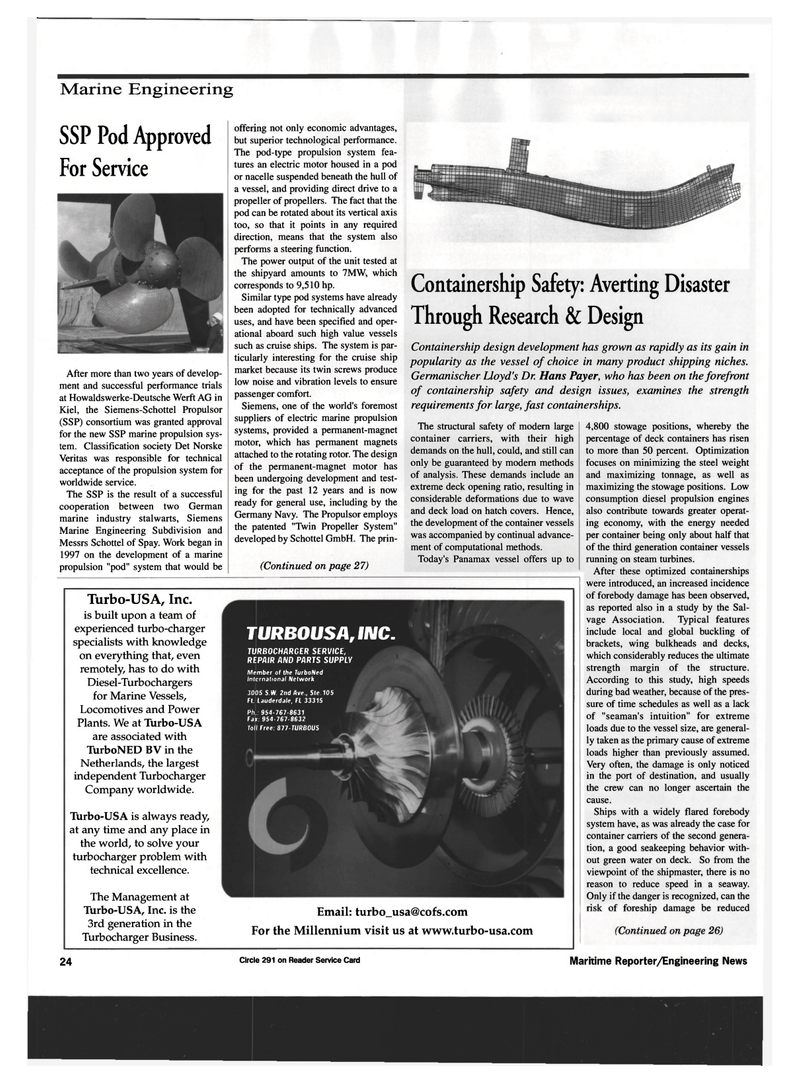
Page 24: of Maritime Reporter Magazine (December 1999)
Read this page in Pdf, Flash or Html5 edition of December 1999 Maritime Reporter Magazine
Marine Engineering
SSP Pod Approved
For Service
After more than two years of develop- ment and successful performance trials at Howaldswerke-Deutsche Werft AG in
Kiel, the Siemens-Schottel Propulsor (SSP) consortium was granted approval for the new SSP marine propulsion sys- tem. Classification society Det Norske
Veritas was responsible for technical acceptance of the propulsion system for worldwide service.
The SSP is the result of a successful cooperation between two German marine industry stalwarts, Siemens
Marine Engineering Subdivision and
Messrs Schottel of Spay. Work began in 1997 on the development of a marine propulsion "pod" system that would be offering not only economic advantages, but superior technological performance.
The pod-type propulsion system fea- tures an electric motor housed in a pod or nacelle suspended beneath the hull of a vessel, and providing direct drive to a propeller of propellers. The fact that the pod can be rotated about its vertical axis too, so that it points in any required direction, means that the system also performs a steering function.
The power output of the unit tested at the shipyard amounts to 7MW, which corresponds to 9,510 hp.
Similar type pod systems have already been adopted for technically advanced uses, and have been specified and oper- ational aboard such high value vessels such as cruise ships. The system is par- ticularly interesting for the cruise ship market because its twin screws produce low noise and vibration levels to ensure passenger comfort.
Siemens, one of the world's foremost suppliers of electric marine propulsion systems, provided a permanent-magnet motor, which has permanent magnets attached to the rotating rotor. The design of the permanent-magnet motor has been undergoing development and test- ing for the past 12 years and is now ready for general use, including by the
Germany Navy. The Propulsor employs the patented "Twin Propeller System" developed by Schottel GmbH. The prin- (Continued on page 27)
Containership Safety: Averting Disaster
Through Research & Design
Containership design development has grown as rapidly as its gain in popularity as the vessel of choice in many product shipping niches.
Germanischer Lloyd's Dr. Hans Payer, who has been on the forefront of containership safety and design issues, examines the strength requirements for large, fast containerships. 4,800 stowage positions, whereby the percentage of deck containers has risen to more than 50 percent. Optimization focuses on minimizing the steel weight and maximizing tonnage, as well as maximizing the stowage positions. Low consumption diesel propulsion engines also contribute towards greater operat- ing economy, with the energy needed per container being only about half that of the third generation container vessels running on steam turbines.
After these optimized containerships were introduced, an increased incidence of forebody damage has been observed, as reported also in a study by the Sal- vage Association. Typical features include local and global buckling of brackets, wing bulkheads and decks, which considerably reduces the ultimate strength margin of the structure.
According to this study, high speeds during bad weather, because of the pres- sure of time schedules as well as a lack of "seaman's intuition" for extreme loads due to the vessel size, are general- ly taken as the primary cause of extreme loads higher than previously assumed.
Very often, the damage is only noticed in the port of destination, and usually the crew can no longer ascertain the cause.
Ships with a widely flared forebody system have, as was already the case for container carriers of the second genera- tion, a good seakeeping behavior with- out green water on deck. So from the viewpoint of the shipmaster, there is no reason to reduce speed in a seaway.
Only if the danger is recognized, can the risk of foreship damage be reduced (Continued on page 26)
The structural safety of modern large container carriers, with their high demands on the hull, could, and still can only be guaranteed by modern methods of analysis. These demands include an extreme deck opening ratio, resulting in considerable deformations due to wave and deck load on hatch covers. Hence, the development of the container vessels was accompanied by continual advance- ment of computational methods.
Today's Panamax vessel offers up to
Turbo-USA is always ready, at any time and any place in the world, to solve your turbocharger problem with technical excellence.
TURBOUSA, INC.
TURBOCHARGER SERVICE,
REPAIR AND PARTS SUPPLY
Member of the TurboNed
International Network 3005 S.W. 2nd Ave., Sle.105
Ft. Lauderdale, FL 33315
Ph.: 954-767-8631
Fax: 954-767-8632 roll Free: 877-TURB0US
Turbo-USA, Inc. is built upon a team of experienced turbo-charger specialists with knowledge on everything that, even remotely, has to do with
Diesel-Turbochargers for Marine Vessels,
Locomotives and Power
Plants. We at Turbo-USA are associated with
TurboNED BV in the
Netherlands, the largest independent Turbocharger
Company worldwide.
The Management at
Turbo-USA, Inc. is the 3rd generation in the
Turbocharger Business.
Email: [email protected]
For the Millennium visit us at www.turbo-usa.com 24 Circle 291 on Reader Service Card Maritime Reporter/Engineering News

 23
23

 25
25
